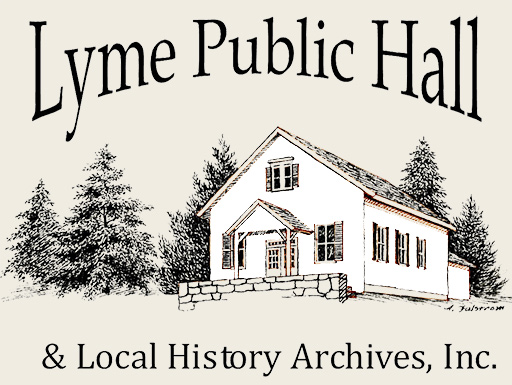The Lyme Grange was established in 1896 as a chapter of the national Grange. Members took turns presenting a talk or short program on a topic of their own interest or current issues at the state or national level that had bearing on rural life. Grange member J. R. Warren wrote and read the following piece at an undated meeting of the Lyme Grange.The text of the talk was reprinted in the Darien Review, Jan. 7, 1916.
— Bit of History of Ancient Lyme —
The ancient town of Lyme gained prominence by furnishing to the commonwealth several governors by the name of Griswold, and harboring men like George Washington and General Lafayette en route from New York to Boston. The buildings that sheltered them are still standing as mute sentinels of honor to guard their memory, lest the present and progressive generation forget their existence. Moses Warren introduced both Washington and Lafayette to the assembled people of ancient Lyme at the place now known as Flanders Corners. The principal thoroughfares through the town were the old Boston Post Road and the Norwich and Essex Turnpike, the terminus of the latter was at a point on Connecticut river known as Ely’s ferry, where passengers were transferred from the old stage coach to the flat bottomed scow propelled by two horses, one on the starboard side and one on the port side. The speed was stimulated by a raw hide in the place of the piston rod. As the captain launched his craft from the shore and grasped the tiller he was no doubt as proud of his command as the master of an ocean liner. As the apron dropped on the east shore, the passengers welcomed the savory odor of broiled shad or a hot joint coming from tavern kitchen, Charles Ely proprietor. Andrew Jackson being one of the guests on a certain occasion, taking passage on the inside route to Boston.
The residence of Miss Eliza Martin was a very popular road house or wayside tavern. It was an up to date hostelry in all its appointments. If Thomas A. Edison could extract some records from these old timbers they would tell of some gay times at the old tavern, lively music in the ball room and the chink of wine glasses from the butlers pantry etc. About one-fourth of a mile from the Pleasant Valley four corners was a carding mill, where farmers used to bring their wool fleeces to be carded into rolls for the spinning wheel. This plant was a wonder in its day and was kept busy with fleeces brought from adjoining towns far and near. On the east bank of the Eight Mile river was a hatters shop where the old time beaver hats (stove pipe pattern) were manufactured for the trade, Beaver Brook running into the valley from the east furnished much of the material. On the east side of what is known as Sleuman’s bridge was located a cider brandy distillery. Some of the old residents said the whole side hill used to be covered with barrels of cider to be converted from a minimum quantity to a maximum of strength. Sam Mathers grocery store at the Pleasant Valley four corners retailed this beverage together with New England rum at the popular price viz. three coppers a swig.
On the Grassy Hill 127 years ago, one Gideon Rogers conducted a general store and nearly every charge on his day-book (which is evidence today) contains an item of indigo and rum, these seemed to be two indispensable articles. Indigo was much in demand as great quantities of yarn was colored for knitting and weaving. Indigo was the most expensive item on the book and rum the cheapest. The whole household drank rum in those days on the same plan or ration as we drink tea at the present time. The people of ancient Lyme were both fed and clothed by home products. The carding mill, the hatters shop, the tan year, the spinning wheel and the loom, furnished man’s outfit from head to foot. The old account book shows no charge for any kind of cloth except domestic weave. Occasionally it shows where a man had purchased a pair of cloth shoes for his daughter. Probably she was making her debut in society.
The ship-yard at Old Hamburg the head of sloop navigation was a busy mart. Here vessels were built, and here they left port loaded with the farmers’ wood and timber, and took passengers to New York, $5.00 single passage which might include a week’s board, depending on wind and tide. The return trip brought merchandise to the two stores located one on each side of the bridge, Jones on one side and Griffin on the other. The present site of Hamburg was then a sand knoll. North of Pleasant Valley on Branch river was located what was known in later years as the old red mill and was operated by William Stark. This was a rival of the old carding mill which soon went out of business. Later a woolen mill was built on the Eight Mile river, operated in early days by one Noyes and still later by Jonathan Earle and last by Rathbun and Son who were rushed with business during the Civil war by government contracts.
The only mention the writer will make of a school is a private institution located in the vicinity of Clover hill. Here young men were prepared for college. The late Judge Charles J. McCurdy was a pupil at this school.
So we leave ancient Lyme and enter the path of progression. When the worthy lecturer of Lyme Grange makes up the [Grange] program one hundred years hence those who respond will probably land in [undecipherable].
Transcribed from an old, very faded news clipping by Molly Turner for the Archives.
********************************************
